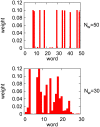Emergence of linguistic conventions in multi-agent reinforcement learning
- PMID: 30496267
- PMCID: PMC6264146
- DOI: 10.1371/journal.pone.0208095
Emergence of linguistic conventions in multi-agent reinforcement learning
Abstract
Recently, emergence of signaling conventions, among which language is a prime example, draws a considerable interdisciplinary interest ranging from game theory, to robotics to evolutionary linguistics. Such a wide spectrum of research is based on much different assumptions and methodologies, but complexity of the problem precludes formulation of a unifying and commonly accepted explanation. We examine formation of signaling conventions in a framework of a multi-agent reinforcement learning model. When the network of interactions between agents is a complete graph or a sufficiently dense random graph, a global consensus is typically reached with the emerging language being a nearly unique object-word mapping or containing some synonyms and homonyms. On finite-dimensional lattices, the model gets trapped in disordered configurations with a local consensus only. Such a trapping can be avoided by introducing a population renewal, which in the presence of superlinear reinforcement restores an ordinary surface-tension driven coarsening and considerably enhances formation of efficient signaling.
Conflict of interest statement
The authors have declared that no competing interests exist.
Figures












References
-
- Lewis D. Convention: A philosophical study. Oxford, UK: Blackwell; 2002.
-
- Nowak M, Krakauer D, Kingdom U. The evolution of language. Proceedings of the National Academy of Sciences. 1999; 96(July): 8028–8033. 10.1073/pnas.96.14.8028 - DOI - PMC - PubMed
-
- Nowak M, Komarova N. Towards an evolutionary theory of language. Trends in Cognitive Sciences. 2001; 5(7): 288–295. 10.1016/S1364-6613(00)01683-1 - DOI - PubMed
-
- Oliphant M. The dilemma of Saussurean communication. BioSystems. 1996; 37(1-2): 31–38. 10.1016/0303-2647(95)01543-4 - DOI - PubMed
-
- Barr DJ. Establishing conventional communication systems: Is common knowledge necessary? Cognitive Science. 2004; 28(6): 937–962. 10.1207/s15516709cog2806_3 - DOI
MeSH terms
LinkOut - more resources
Full Text Sources

